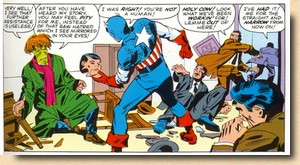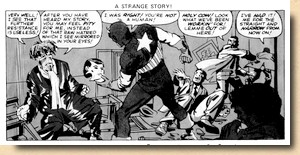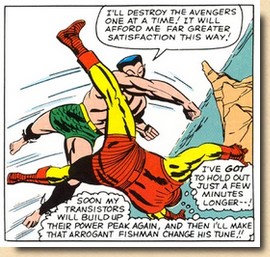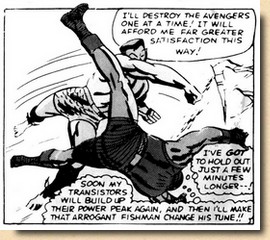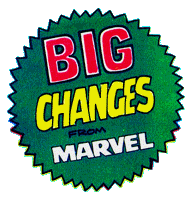| |
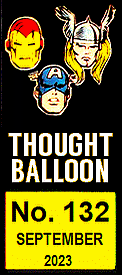 |

 SPOTLIGHT
ON
SPOTLIGHT
ON
MARVEL
UK's
AVENGERS
WEEKLY #1
(SEPTEMBER
1973)
|
|
|
|
| |
|
| |
THE
AVENGERS
"Captain
America joins... The Avengers!"
(22 pages)
Reprint
minus page 6, originally published in Avengers
#4 (March 1964)
Story - Stan Lee
Pencils - Jack Kirby
Inks - George Roussos
Lettering - Art Simek
DR.
STRANGE
"The
Origin of Dr. Strange"
(8 pages)
Full
reprint, originally published in Strange
Tales #115 (December 1963)
Story - Stan Lee
Pencils -
Steve Ditko
Inks - Steve Ditko
Lettering - Sam Rosen
The cover
is composed of artwork from various sources
|
|
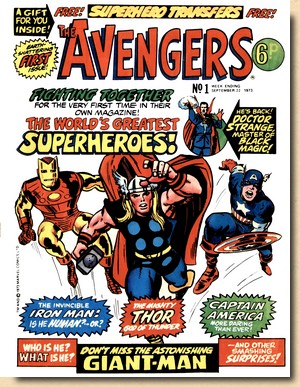 Avengers
Weekly
#1 (UK, 22 September 1973) Avengers
Weekly
#1 (UK, 22 September 1973)
|
|
| |
|
| |
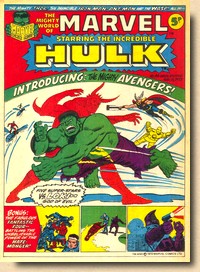
Mighty
World of Marvel #46 introduced the Avengers
(18 August 1973)
|
|
THE MIGHTY WORLD OF MARVEL (UK)
On the last Saturday of
September 1972, a new comic book appeared on
British newsagent stands. Cover dated "week
ending Oct. 7, 1972", Mighty World of Marvel #1 heralded the beginning of Marvel
UK (as the House of Ideas' British imprint would
soon be known as).
The first issue of Mighty
World of Marvel (which would quickly acquire
the affectionate acronym of MWOM)
started out with the origin stories of the Hulk,
the Fantastic Four and Spider-Man, and quickly
proved to be the huge success Marvel no doubt had
hoped for. A little more than four months and 19
issues after the launch of MWOM, Marvel
UK made its next move to increase its share of
the British market by launching their second
weekly on February 10th 1973 - Spider-Man Comics
Weekly (SMCW for short).
Thor was introduced as
the back-up feature in SMCW whilst
Daredevil took the place of Spider-Man in the
pages of MWOM, adding yet more
superheroes to the growing ranks of Marvel UK -
and these were expanded further in August 1973
when the Avengers were introduced in Mighty
World of Marvel #46, starting out with the
classic Stan Lee / Jack Kirby origin tale from Avengers
#1.
|
|
| |
|
| |
|
AVENGERS ASSEMBLE!
Marvel UK's two weeklies
- Mighty World of Marvel and Spider-Man
Comics Weekly - were selling extremely well
all over the UK.
It
therefore wasn't long until a third weekly title,
along with more Marvel characters, hit the news
agents.
|
|

|
|
| |
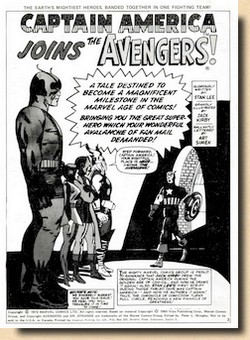 |
|
Only
a mere month after having made their debut in the
pages of Mighty World of Marvel, the
Avengers, were moved to their own title - aptly
named The Avengers and hitting the UK's
news stands the week ending on 22 September 1973.
Since
the adventures of this team of superheroes had
kicked off four weeks prior in the pages of Mighty World Of
Marvel, the reprints of their US material
simply continued into The Avengers
with the now classic story from
Avengers #4
(March 1964), which famously marked the
re-introduction of Captain America (an expanded
synopsis of the storyline can be found
here).
As a consequence, readers
who picked up the first issue of this new weekly
without ever having read a single copy of MWOM
would be at something of a loss as to who and
what exactly this group of superheroes were - and
for obvious reasons, the original splash page
from the US Avengers #4 didn't really
provide any help in that direction either.
However, editorial at
Marvel UK did provide something of a hint through
the title headlines that were being added to
every single page at the time - which in this
case read "The Earth's Mightiest Heroes,
Banded Together In One Fighting Team!".
The
Avengers were joined in their own title by Doctor
Strange, adding yet another character to the
growing ranks of Marvel UK.
|
|
| |
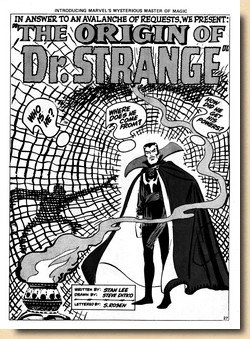 |
|
Doctor Strange (or Dr. Strange,
as he was named in his early days) had
featured in UK reprints published by
Odhams Press in the early issues of Terrific!
back in 1967 (the same publisher also
reprinted some Avengers material in
issues of Smash! in 1966).
However, since
the vast majority of readers who picked
up the new weekly Avengers in
September 1973 would know nothing about
Stephen Strange, it made sense to launch
him into the fold of Marvel UK not with
his actual first appearance from Strange
Tales #110 (July 1963) but rather
with his origin tale from
Strange
Tales #115 (December 1963).
Back in 1963 Stan
Lee had been playing catch-up with this
origin feature, since the Sorcerer
Supreme had already featured in five
previous issues of Strange Tales.
And in typical Marvel style, readers were
let in on the fact that "we
forgot to give you his origin"
- "it could only happen to the
off-beat Marvel Comics Group!"
|
|
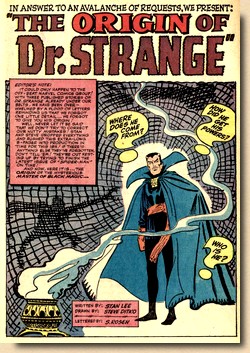 |
|
|
| |
| Whilst this served the purpose of establishing the
"club atmosphere" for readers of Marvel comics
at the time (after all, what's a little slip-up amongst
friends), it clearly would have made no sense to readers
of Marvel UK's Avengers #1, since this was the
very first time they encountered Doctor Strange.
Accordingly, the fairly large text box on the
introduction page was dropped and the entire page
reworked in order to avoid having too much empty space. It was all part of editing the US
material for the UK weeklies, which featured various
approaches and tasks. At the time of publication of Avengers
#1, editorial oversight was in the hands of Peter L.
Skingley - who was, in fact, Petra L. Skingley. Seemingly
the common publisher's wisdom of the time dictated that "boys comics" should have
male editors, even if by "pen name" only.
|
| |
|
| |
EDITING ORIGINAL
MATERIAL FOR MARVEL UK'S WEEKLIES
|
| |
|
Editorial at Marvel UK had a
number of options at hand to adapt the original material
for their use in the UK weeklies, and most issues ended
up with more than one tweak - as is indeed the case for Avengers
#1. |
| |
|
EDIT
#1 - LEAVE OUT MATERIAL
Usually
this meant dropping an entire
page (or two) of the original
material, but what sounds like a
fairly drastic thing to do was
actually also established
practice at Marvel US in the
1970s, because many of its 1970s
reprint titles by then had a
lower page count than the 1960s
issues they featured. This
editorial measure therefore
differed fundamentally from e.g.
the still common practice in the
early 1970s to cut scenes from
movies for what in essence were
reasons of censorship.
Nevertheless, it did of course
affect the integrity of the work.
On the other hand, a lot would be
going on within the 20+ pages of
a 1960s comic book story, and if
done properly, the omission would
hardly be noticeable. Case in
point: the omission of page 6
from
Avengers #4
(March 1964) in
Marvel
UK's
Avengers #1
(September 1973).
Comic book
stories from the Silver Age would
often feature "plot
loops" which would insert a
little sub-story before getting
back to the course of the main
events, and the page that had to
be dropped for lack of space in
Marvel UK's first issue of The
Avengers does precisely
that. The team is somewhat
uncertain about the authenticity
of Captain America and voices
their concerns (panel 1), leading
Cap to give a demonstration of
his capabilities (panels 2-5)
which results in a "we're
convinced" conclusion
(panel 6).
|
|
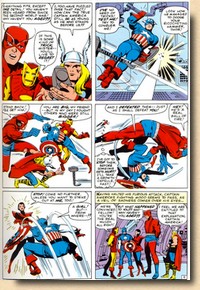
Avengers #4,
page 6
(March 1964)
|
|
|
|
| |
| To some degree, the cropping of
panels falls into this category of editorial adjustments
as well. This editorial measure was deemed necessary in
the early days of Marvel UK in order to better fit the original material
onto a British comic book page - the size of which (21.6cm
x 28cm; 8.5" x 11") differed from the standard US comic book page
(18.1cm x 26.7cm; 7.1/8" x 10.5"). |
| |
|
| |
| In comparison
to some reprints of Marvel material by UK
publishers in the 1960s (who would at times
completely rearrange panels and pages with wild
abandon), this editorial intrusion is clearly a
very minor form of "mutilation" - which
also is by no means unique to comic books, as
many film aficionados can attest to when it comes
to aspect ratios. Ultimately, however,
this editorial effort was deemed unnecessary and
subsequently dropped completely - not the least
because it was an extremely tedious job,
which in 1972 and 1973 was assigned to a young
Dave Gibbons (later to gain fame as an artist in
his own right for e.g. Watchmen).
"I got a call
from a guy called Rob Barrow [who had] heard
from a lady called, I believe, Pippa Melling
who was the de facto editor of the
about-to-start MWOM. The production prints
they'd received from the States still had US
spelling. Rob knew that I'd done lettering
for Fleetway and thought I would be just the
man. I met up with Pippa in the offices they
then had in High Holborn and agreed the
details (...) I worked on high quality prints
mounted on heavy board, using strips of patch
paper to do the corrections. A fiddly
business (...) I had to cut the patch with a
scalpel held at an angle, to chamfer the
edges and prevent shadow, then go round each
edge with white-out, just to make sure (...)
I would get pages through the mail, do the
corrections and mail them back, usually under
a tight deadline. I can't remember when or
how I stopped, but I would guess that they
took to doing the corrections in the
US." (Dave Gibbons, in Stringer
2007)
|
| |
|
|
EDIT
#2 - ADD MATERIAL
Adding
material as an editorial measure
usually meant small added tweaks,
although this would include
splashpages specially produced
for the British weeklies in New
York once Marvel UK's titles went
on to feature three or more
characters in one issue,
necessitating segmentation of the
original material.
An example for a smaller
editorial tweak actually serves
to smooth the transition of the
original material over the gap
created by dropping page 6 from
Avengers
#4 (March 1964) - the
addition of a word balloon with
Thor wondering "But how
is this possible?" is
answered by the first text panel
of the next page: "Slowly,
almost haltingly, the incredible
tale begins to issue forth from
the lips of the mighty man with
the tragedy-haunted eyes..."
- although for some reason
editorial felt the need to change
"the
incredible story"
to "an
incredible story"
(which admittedly sounds better
stylistically). At this point in
time there was quite a lot of
effort put into textual details
such as this one - an approach
which would fall by the wayside
rather quickly once more material
was published.
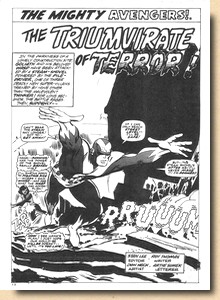
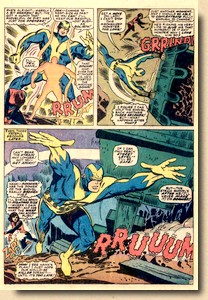
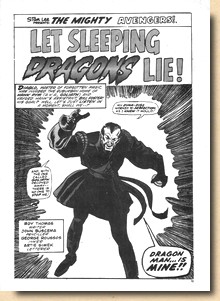
Avengers #45
(UK, July 1974), Avengers
#39 (April 1967), Avengers
#49 (UK, August 1974)
|
|
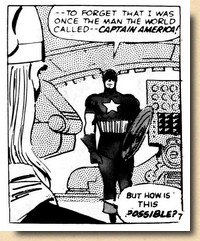
Avengers #1
(UK, September 1973)
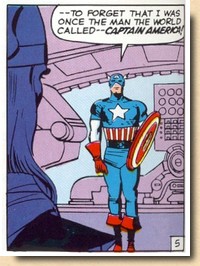
Avengers #4
(March 1964)
|
|
|
|
| |
| Early splash page additions (required to segue
readers into a segment of a story originally published
within one single issue) were simply made by turning
using a panel from the story (in the case of UK Avengers
#45 even featuring the nice added touch of a credit panel
which, for obvious reasons, is lacking in the panel
lifted from US Avengers #45). Later splash pages
would be more elaborate productions, sometimes featuring
fully original artwork. the other
end of the affair (cutting away and leaving an original
storyline to be continued in next week's issue) was
obviously a much easier editorial task - sometimes
applied with a bare minimum text panel, and sometimes a
tad more elaborate, even attempting to imitate Marvel's
amicably and quippy style.
 
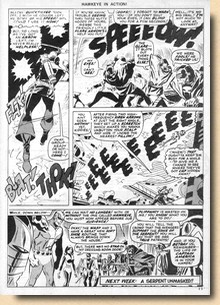
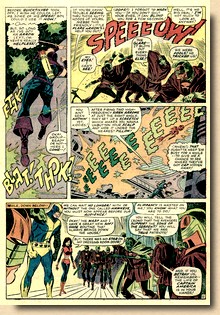
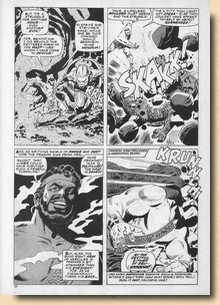
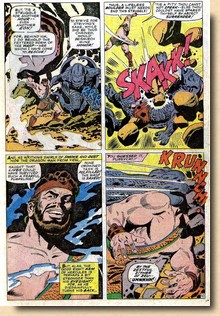
Avengers
#32 (UK, April 1974), Avengers #33 (October
1966), Avengers #50 (UK, August 1974), Avengers
#42 (July 1967)
|
| |
EDIT #3 - MIX AND MATCH
MATERIAL
In some (albeit rarer) cases, it was
necessary to cut and paste the original material in a
"mix and match reprint" approach. In the
example shown here, page 14 of Spider-Man Comics Weekly #47 (January
1974) never existed in that form in the original
Amazing Spider-Man #53
(October 1967).
|
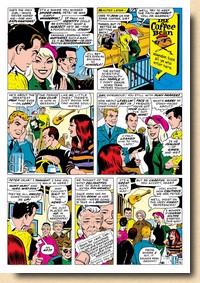 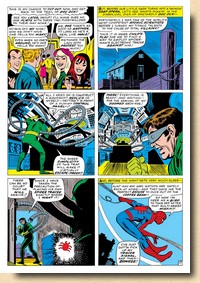
Amazing
Spider-Man #53
(October 1967)
|
|
In
order to fit the original
material to the page
count of SMCW
#47 and in addition to
dropping two pages
outright, editorial took
the first panel of the
original page 17 and
spliced it onto page 18
as the first panel of
that page, thus turning
two original pages into
one reprint page. On
the surface of things, UK
readers "only"
missed out on some social
interaction between Peter
Parker and his friends -
but on closer inspection
this included the
information that Aunt May
was looking for a boarder
(a fact which would prove
to be a major plot
linchpin).
|
|
|
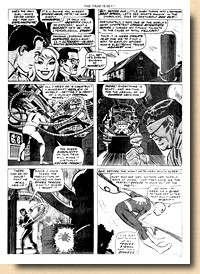
Spider-Man Comics
Weekly #47
(UK, January 1974)
|
|
|
|
| |
|
Spider-Man Comics
Weekly #47 is an example of the rougher kind of
editing that sometimes took place at Marvel UK,
effectively making readers miss out on almost 3 out of 20
pages of the original story as presented in Amazing
Spider-Man #53. It must have been clear to the
powers in charge from the outset that this would not work
as a regular approach - and as of Spider-Man Comics
Weekly #50 (January 1974), the reprints were
presented in segments of between 9 and 12 pages of
material from an original US issue. |
| |
EDIT #4 - ADAPT
TO THE UK PUBLICATION SCHEDULE
The fact that
Marvel UK's titles were published weekly also
required a number of editorial patches with
regards to the somewhat frequent references to
previous events and storylines and when and where
they were published.
|
|
| |
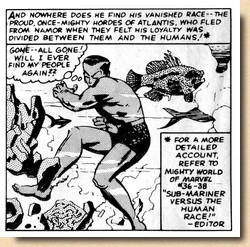
Avengers
#1
(UK, September 1973)
|
|
The tweaks editorial had to
effect in this respect could include any or all
of the following: -
references to time (e.g. change "as seen
in last month's issue" or "to
be continued next month" to weekly
references), or
- references to issues
(sometimes this would just require changing an
issue number, but most often the title had to be
changed too, as in this example from UK Avengers
#1 which originally referenced a story from Fantastic
Four Annual #1 reprinted by Marvel UK in Mighty
World of Marvel #36-38).
Sometimes references also
simply had to be dropped because they referred to
material not (yet) reprinted in the UK.
|
|
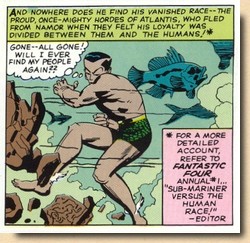
Avengers
#4
(March 1964)
|
|
| |
EDIT #5 - ADAPT
TO THE UK READERSHIP
There are a
number of well-known differences between US and
British spelling, and (at least initially) Marvel
UK went to great lengths to adapt the original
material accordingly.
|
|
| |
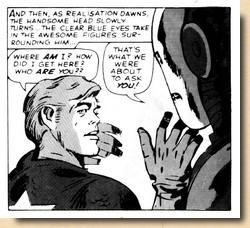
Avengers
#1
(UK, September 1973)
|
|
One example from Avengers
#1 changes the US "realization"
to the correct British spelling "realisation",
and the individual doing those
alterations in 1972 and 1973 was, again,
then 23-year-old Dave Gibbons.
"I did all the
anglicizing of spelling in the first
year or so (...) As it generally
involved lengthening words
("colour" for
"color", say), I often had
to redo whole lines of copy."
(Dave Gibbons, in Stringer 2007)
The reputation of
comic books in the early 1970s still
found itself on shaky grounds at times,
and Marvel UK clearly didn't want to get
caught promoting wrong spelling and, to a
lesser degree, grammar.
|
|
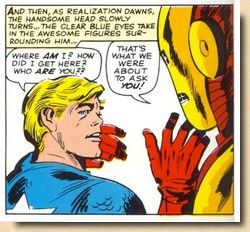
Avengers
#4
(March 1964)
|
|
|
| |
|
| |
SPREADING MARVELDOM
|
| |
| Stan Lee was heavily into an "international
dream" (Kirby, 2019) for Marvel, but nobody had
originally planned or intended for the House of Ideas to
publish its material in the UK themselves. It was only
when a collaboration deal with London based comic book
distributor Martspress Ltd (Beal, 1997) fell through -
leaving Marvel with a substantial investment at risk -
that the (somewhat forced) decision was made to go it
alone (Kirby, 2019). It would
quickly turn out to be yet another success story. Marvel UK, as
the British imprint would become known as, not only
established a sense of order and chronological continuity
(which had been sorely lacking in the licensed UK
reprints of the 1960s) for readers, but also - and
perhaps most importantly so - the feeling of
authenticity.
|
| |
|
This was
truly the House of Ideas at work, and readers in
Britain now got their real share of Merry
Marveldom - not only its visual house style, but
also its friendly and chatty (often
tongue-in-cheek, and sometimes waaaay over the
top) editorial style as established by the Maestro
Supreme Stan Lee. It all was essential in
creating a sense of community. Having
the original and not a watered-down copy was a
first for British comic book readers - and it
struck a welcome sentimental chord with seasoned
readers accustomed to the US publications. The
"Bullpen Bulletins" became a feature of
the UK weeklies as much as they were an integral
part of Marvel's US comic books, and during the
first two years of Marvel UK also contained an
anglicised version of Stan Lee's famous
"soapbox". Inspired by the way how
William Gaines and his EC Comics reached out to
and involved readers of their titles in the early
1950s, Stan Lee understood (possibly like no
other) the magic of creating something of a club
atmosphere and making readers feel that they were
actually part of something special.
"I
didn't want us to be doing these books in a
vacuum, because you know comic books had no
advertising budget, no promotion. There were
no ads on television, on the radio, in
newspapers - you just printed your comic book
and it was out there, and I was (...) on a
crusade, a mission, to let the world know
about the marvelous world of Marvel. So in
that sense, I guess I was a little bit of a
huckster." (NN, 2003)
Just
as their American counterparts, Marvel UK's
titles also featured regular in-house advertising
- which always served a double purpose at the
House of Ideas, since presentation played a huge
role in accentuating the "wonderful world of
Marvel". Accordingly, the issues of Mighty
World of Marvel preceding the launch of The
Avengers all carried ads promoting the new
weekly title.
|
|
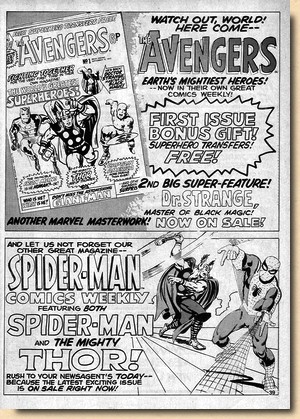
Mighty
World of Marvel #51
(29 September 1973)
|
|
| |
| And as had been the case when
Mighty World of Marvel and Spider-Man Comics
Weekly were launched, the first issue of Avengers
featured a welcoming message. However, things were
a bit different this time around. There was no double
page spread but rather just two thirds of page 13, and
there was no mentioning of who was actually addressing
the "adventure lover" holding the
comic book. It feels somewhat odd that the name Stan Lee
isn't mentioned in this context - possibly an editorial
slip-up. |
| |
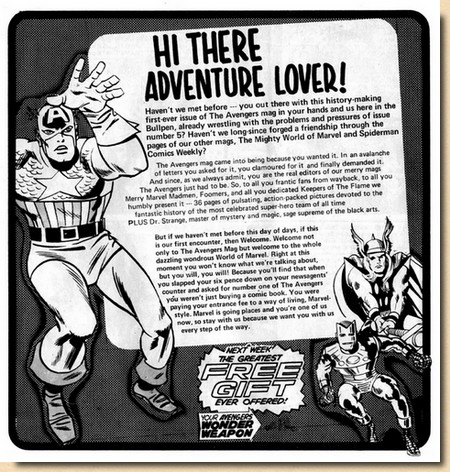 |
|
The style in which readers
were being greeted to this new weekly comic book
did, however, sound very much like Lee's banter
and hyperbole.
"The
Avengers mag came into being because you
wanted it. In an avalanche of letters you
asked for it, you clamoured for it, and
finally demanded it."
Taking into
account that there would also be first time
readers who knew nothing about Marvel nor the
other two weeklies, they were duly informed that
"when
you slapped your six pence down on your
newsagents' counter and asked for number one
of The Avengers you weren't just buying a
comic book. You were paying your entrance fee
to a way of living, Marvel-style. Marvel is
going places and you're one of us now, so
stay with us because we want you with us
every step of the way."
Keeping up
the British comic book tradition of free gifts in
the first few issues of a new title (Mighty
World of Marvel #1 came with a Hulk iron-on
transfer, Spider-Man Comics Weekly #1
with a printed paper bag advertised as a
Spider-Man Mask, and Avengers #1 again
with transfers), readers were promised "the
greatest free gift ever offered" with the
next week's second issue of The Avengers.
The "Wonder Weapon" turned out to be a
flat cardboard gun which used a rubber band to
fire flat cardboard discs...
|
|
| |
| The Avengers also brought changes to the
entire line of Marvel's UK weeklies, introducing glossy
colour covers - as well as a drop in page count from 40
pages to 32. |
| |
|
| |
AVENGERS ASSEMBLED
|
| |
| The line-up of The Avengers continued with
two features (the Avengers and Dr Strange) until
Shang-Chi, Master of Kung Fu, was added to the fold as of
Avengers #28 (30
March 1974), resulting in what would become the defining
and typical format of Marvel UK^s weeklies: original
material from one US issue cut into segments and spread
out over two (or more) UK issues. |
| |










